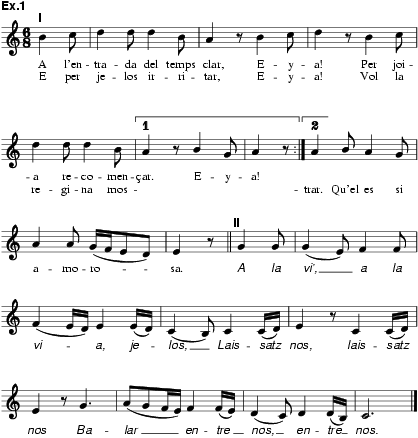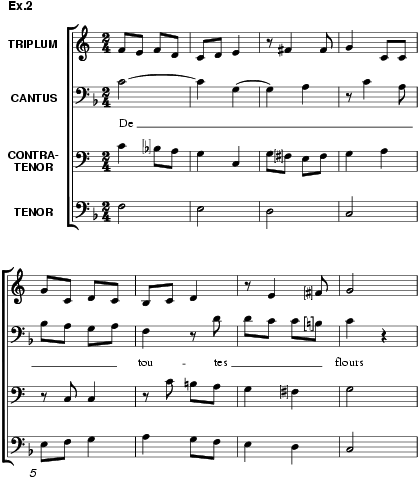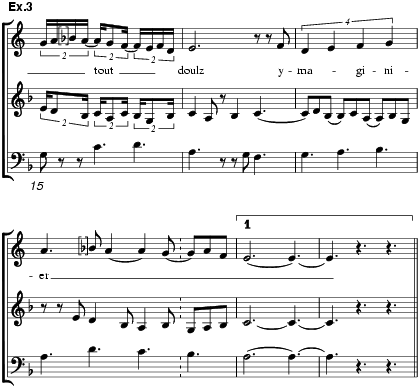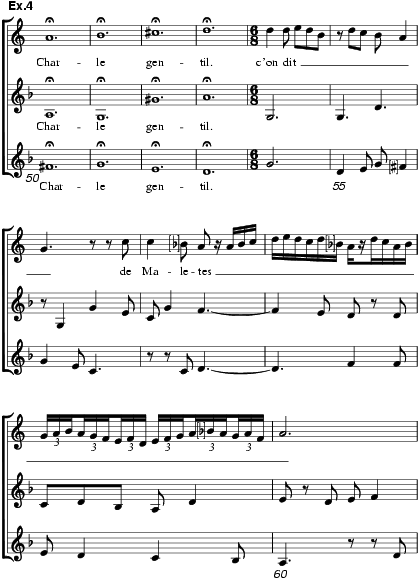
One of the three formes fixes (the others are the rondeau and the virelai) that dominated French song and poetry in the 14th and 15th centuries. In its standard late medieval shape the ballade text falls into three stanzas, sharing the same metrical and rhyme scheme and ending with the same refrain. The music for each stanza follows the overall pattern I–I–II. Approximations to this form can be found in monophonic song in the 12th and 13th centuries, when the distinction between the ballade and the virelai in particular was not completely clear. Indeed, even in the 14th century, Machaut called his virelais ‘chansons baladées’.
The word ‘ballade’ is derived from Provençal ballada, from balar, to dance; the ballade, rondeau and virelai were in their earliest phase songs for dancing, the most common dances being the carole and the tresche. One of the most attractive of the few surviving examples in Provençal is the spring song A l’entrada del temps clar (ex.1) contained in the 13th-century Chansonnier de St Germain-des-Prés (F-Pn fr.20050; see Sources, MS, fig.25), though it is more likely to be a learned imitation than a genuine piece of folksong. There are five stanzas altogether, each with the characteristic repetition of the first musical section including varied endings for the first- and second-time bars, followed by the second musical section (here occupied entirely by the refrain, though later this normally took up only the last line or so). The musical form I–I–II, it should be noted, is the commonest form underlying the most important of early medieval song types, the Provençal canso and French chanson d’amour. These, however, normally had five or more stanzas, no refrain and a final envoi of a few extra lines; they persisted into the 14th and 15th centuries as the chant royal, and during that period poets using the ballade form without musical setting frequently borrowed the envoi to close their piece.

The 13th-century French chanson à refrain is sometimes close to the ballade, and a few examples with three stanzas only are known, such as Li louseignolés avrillouz by the Arras trouvère Guillaume le Vinier, though the versification here is uncharacteristically complex. One source (GB-Ob Douce 308) gives 188 examples described as ballettes, though sadly they are divorced from their presumed musical setting. These display great flexibility in structure as regards the placing of the refrain, metre, rhyme and the number of stanzas. It is to be noted that the 14th-century Italian Ballata is akin to the 14th-century virelai in form, not to the ballade. The flexible ballette gave way, at the very close of the 13th century, to a more rigid classification, in which ballades retained refrains in the final position, whereas virelais placed them in the initial position.
The earliest known polyphonic settings, composed by Adam de la Halle in the late 13th century, reflect the ballette stage. Of his 16 rondes, as the sources call them, 14 are clearly in rondeau form, which had taken on its definitive shape much earlier; but two approximate either to the later ballade or to the virelai: no.4, Fines amouretes ai, and no.16, Dieus soit en cheste maison. If we ignore the initial refrain (C7–C7) of this latter piece, it then has ballade-like proportions, though there are only two stanzas. Starting at line 3, it can be represented thus: I(a5–b7) I(a5–b7) II(b7–c5–C7–C7).
With the Parisian Jehannot de l’Escurel (d 1304) we find that all three forms, ballade, virelai and rondeau, are completely distinct one from another. Jehannot left 32 settings of lyrics of which 15 are ballades, all monophonic. Amours, que vous ai meffait is fairly typical in its style and structure: I(a7–b7) I(a7–b7) II(b7–c7–B7–C7). The first musical section has the characteristic first-time (Ouvert) and second-time (clos) cadences, and the whole melody shows a greater rhythmic freedom than in the work of Adam de la Halle. This was largely due to the greater refinement of a notational system that already had many of the features of Ars Nova notation. Jehannot’s ballades display a flexible approach within the general framework. In some stanzas only one line takes up the whole of the first musical section; in others shorter lines come at almost any point in the setting; in others the refrain is two or more lines long. The early 14th-century taste for eight and three syllables to the line was superseded towards the middle of the century by a preference for ten and seven syllables, though many exceptions can be found.
In Guillaume de Machaut’s ballades the refrain is normally one line long; and the short line of text, if any, normally opens the second musical section, as in a typical example, De toutes flours (bars 1–8, ex.2): I(a10–b10) I(a10–b10) II(c7–c10–d10–D10). In this piece a number of important developments appear. The most notable are: elaborate melismas, especially on final syllables; frequent use of syncopation; setting for solo voice with accompanying parts that are clearly instrumental; and extension of the second musical section to give the refrain greater prominence, preceded and closed by a cadence and reiterating material from the finish of the first musical section. Machaut’s contribution was above all to standardize the formes fixes and to make them popular; however, among the 42 ballades that he set to music are a number that show a continued interest in experimentation. One of these, Dous amis, oy mon complaint, has a fairly elaborate metrical structure of a type more often found in the virelai: I(a7–a4–a3–b7) I(a7–a4–a3–b7) II(b4–b3–a7) II(b4–b3–A7). The most striking feature here is the repetition of the second musical section as well as of the first; this extension of the normal form is to be found in a number of 14th-century examples, sometimes described as baladelle. Machaut’s ‘double ballade’, Quant Theseus/Ne quier veoir, is notable for its application to ballade setting of the 13th- and 14th-century motet polytextual technique; here two voices simultaneously sing different texts, though on the same subject, with the same metre and the same refrain. This idea, too, was taken up in a number of 14th- and 15th-century settings of virelais and rondeaux as well.

The Ars Subtilior of the late 14th century brought no structural advance to the composition of the ballade. But the highly inventive poet-musicians who were fostered in the southern courts of Orthez, Navarre, Barcelona and Avignon – such as Cuvelier, Antonello da Caserta, Philippus de Caserta, Senleches, Trebor, Solage, Vaillant and Matteo da Perugia – as well as composers in Cyprus, introduced very intricate and subtle rhythmic ideas and often permitted passages of extreme dissonance, while maintaining the setting for the basic forces of voice (mostly in the tenor or countertenor range) and two or three accompanying instruments. Ex.3, bars 15–20 of Philippus de Caserta’s En remirant vo douce pourtraiture, is typical.

Late 14th-century ballade texts are often in praise of patrons or in celebration of historical events; in the main, however, the ballade was throughout its history the preferred form for the serious love song. Machaut wrote nearly 200 ballades contained in his La louange des dames with no musical setting, nearly all on the theme of courtly love. The increasing complexity of musical composition must have been the main contributing factor to the subsequent divorce between poets and musicians; after Machaut no major French poet set his own verses to music, though many, such as Froissart, Deschamps, Christine de Pisan, Chartier, Charles d’Orléans and Villon, continued to use the formes fixes, in particular the ballade and the rondeau. In the musical context the ballade receded from favour in the early 15th century when the rondeau became extremely popular. (For a more detailed discussion of the relative popularity of the three principal forms in the 14th and 15th centuries see Virelai.)
15th-century Burgundian composers nevertheless produced a number of pieces in ballade form. The main innovation, apart from the relative simplicity in style, which was itself a reaction against previous excesses, is the frequent use of a purely instrumental introduction before the entry of the singer(s). Composers such as Binchois and Du Fay were able to put their individual stamp on the ballade, as is amply demonstrated by the striking passage in ex.4, from Du Fay’s Resvelliés vous. This type of song was popular in Italy and was emulated in England, for instance by Walter Frye or Johannes Bedyngham. Later in the 15th century, Dutch and German examples are found, often in Florentine songbooks. Attempts to combine texts and melodies of different national origins generally resulted, however, in the breakdown of the traditional formes fixes.

For bibliography see Chanson.
NIGEL WILKINS